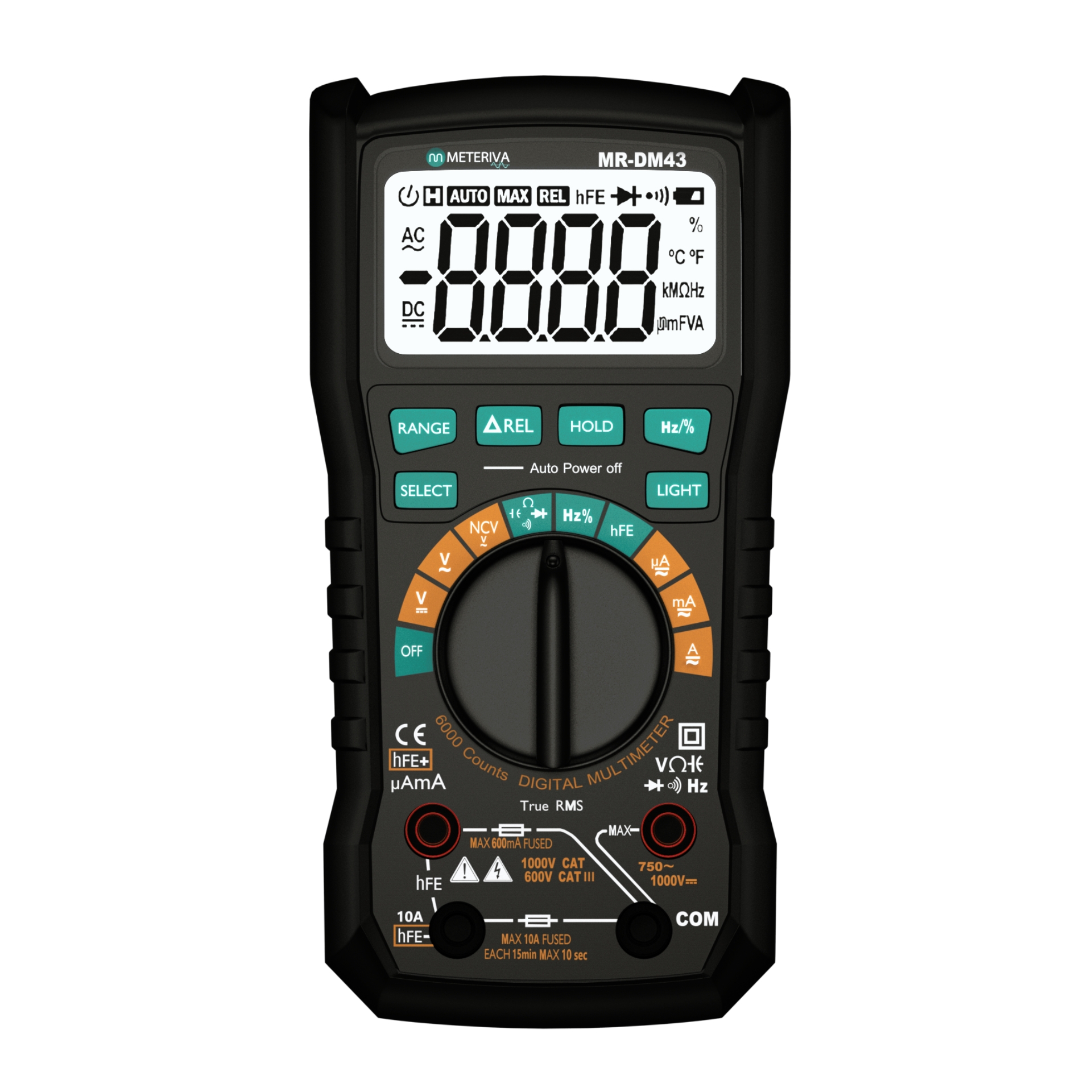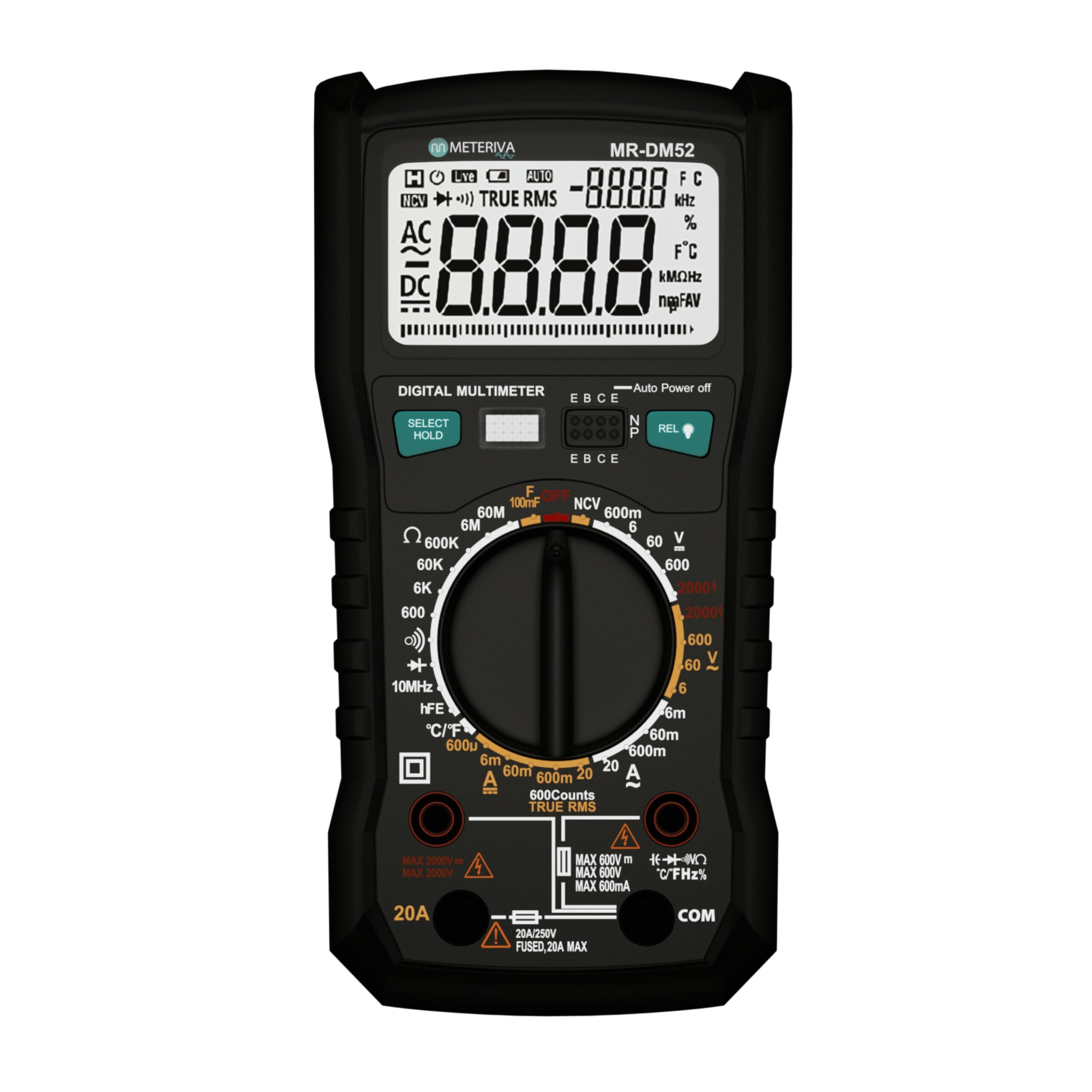Digital Multimeter
Measure with Precision, Power with METERIVA Digital Multimeter.
METERIVA® Multimeter is a measuring instrument that can used to measure voltage, current, and resistance in electrical circuits. The multimeter, also called a Volt-Ohm meter. There are two types of multimeter i.e. Analog and Digital Multimeter. The main difference between the analog multimeter and the digital multimeter is in their display mechanisms. Analog multimeters use a moving needle to display electrical measurements. And digital multimeter uses a digital display to show the values of electrical measurements.
Digital Multimeter In Use
Introduction to Digital Multimeters
METERIVA® Digital multimeter is one extremely helpful instrument for evaluating electrical properties in numerous applications. As per the definition of a digital multimeter, the primary function of a multimeter is to measure significant variables such as voltage, current, and resistance.
- Measure the voltage of a circuit to determine its capacity for current transfer, which is the difference in electrical potential between two places.
- The passage of electrical charge, frequently carried by electrons, indicates the current in a wire.
- Resistance is a measure of how much a substance resists the flow of electricity.
You can utilize accurate information from the digital multimeter reading to identify and fix problems with electronic circuitry.
Whether you’re using it to check plugs at home, identify electrical issues in your car, or evaluate battery performance issues, a multimeter is an incredibly helpful tool.
What is a digital multimeter used for?
Digital multimeters, particularly the true RMS ones, are essential for reliable readings in both sinusoidal and non-sinusoidal AC waveforms in many professional applications. Applications include element resistance, device resistance, and circuit voltage monitoring.
- We use the digital multimeter to determine the circuit current and evaluate the fuses, switches, capacitors, diodes, and robustness of the connections.
- Digital multimeter is used in determining the frequency of an AC transmission; if the multimeter is equipped with the right inputs, taking a temperature reading.
Their practicality spans from fieldwork to product testing, making them necessary in moment’s electronics assiduity. Common uses include
- Device or circuit voltage dimension
- Element resistance measures
- Measuring the current flowing through a circuit
- Measuring durability on factors similar as switches, connections, and fuses
- Testing diodes
- Measuring a capacitor’s value
- Measuring the frequency of an AC signal
- Temperature dimension
How to Use a Digital Multimeter?
Digital multimeters combine voltmeter, ammeter, and ohmmeter functions into one device to provide customized adjustable options.
Four primary channels are present in a digital multimeter:
- Screen Used to display measures.
- Buttons Used to handpick functions.
- Telephone or switch Used to choose the type of dimension.
- Jacks for connecting multimeter probe test leads.
How to Choose a Digital Multimeter?
Selecting a digital multimeter might be challenging, but it’s important to consider features, specifications, and intended application. Choose a model that blends nicely with your interior design while considering how durable it is to use on building sites. Depending on how portable you require it to be, choose from a variety of little possibilities.
For the task at hand, choose the digital multimeter with the appropriate degree of precision. You need to choose characteristics for multifunctional models according to your demands, even though they are very versatile. When choosing a multimeter, make sure it meets the requirements for safety as the most important thing. This is especially true when using one. Choose a model that fits all of your needs and is reasonably price.
Types of Digital Multimeters
Digital multimeters are categorized according to the roughly 20,000 counts that each group is capable of handling.
- General purpose: Because these digital multimeters are reasonably priced, sturdy, and easy to use, they are perfect for conducting basic electrical testing.
- Standard models: Digital multimeters with specific functions like frequency dimensioning and diode testing are more sophisticated than general-purpose devices.
- Advanced performances: Wireless networking and data recording are two of these digital multimeters more sophisticated functions.
- Compact units: Portable digital multimeters are small and light instruments. They are perfect for technicians who have to carry their tools about.
- Wireless models: These digital multimeters allow employees to take measurements anytime they’d like by connecting via Bluetooth or Wi-Fi to a mobile device.
Tips for Using a Digital Multimeter Safely and Correctly
The digital multimeter is use for any electrical operation entails inherent safety risks. Read the stoner primer before using any electrical testing equipment. Comprehensive guidelines on safe operation practices, security measures, and functional limitations are included. Both the automobilist’s safety and the delicacy of the acts depend on adherence to these safety laws and regulations.
Digital Multimeters Applications
Digital multimeters can be useful for a wide range of scripts and detail levels. These are essential tools for many tasks, such as evaluating battery performance, characterizing and testing electronic components, spotting electrical issues in cars, and inspecting outlets, switches, and wiring for functioning and safety. Complex ministries in fictitious environments also require them for maintenance and administration.
The following are some typical uses for digital multimeters:
- Troubleshooting Electrical Problems Digital multimeters are used by technicians to identify open circuits, films, and other issues with electrical systems. Resistance, voltage, and current in point problems are rapidly identified by them.
- Electronics Testing in electronics laboratories, digital multimeters are used to test and characterize various components, including diodes, capacitors, and resistors. They support the assurance that the necessary elements are in place for a postponement.
- Battery Testing Digital multimeters are useful tools for evaluating both rechargeable and non-rechargeable battery performance. They can ascertain the condition and charge level of the batteries by monitoring resistance and voltage.
- Automotive Diagnostics Mechanics Digital multimeters are used by auto mechanics to identify electrical problems in vehicles. They are able to check the battery voltage, test the detectors, and identify any issues with the car’s electrical systems.
- Electrical Work at Home When it comes to DIY projects and home electrical upkeep, digital multimeters are an invaluable tool. It is possible to verify that outlets, switches, and wiring are secure and functional.
- Since digital multimeters enable artificial conservation in artificial surroundings, they are indispensable for intricate ministry monitoring and maintenance. They can prevent costly issues by identifying irregularities in electrical systems.
- Renewable Energy Digital multimeters measure the output of solar panels, wind turbines, and other renewable energy sources. They also employ them in component testing, temperature measurement, and electrical troubleshooting for HVAC systems.
For both experts and enthusiasts of colourful diligence, digital multimeters are fantastic instruments. Because of their improved features and accountability, they differ from antiquated analog measurements in that they deliver precise voltage, current, and resistance readings.
Always put your safety first when using a digital multimeter, and abide by the instructions listed in the stoner introduction. These tools are vital to today’s technologically advanced civilization due to their versatility and potential uses in artificial conservation, HVAC systems, renewable energy systems, battery analysis, car diagnostics, home electrical maintenance, and electrical troubleshooting.


